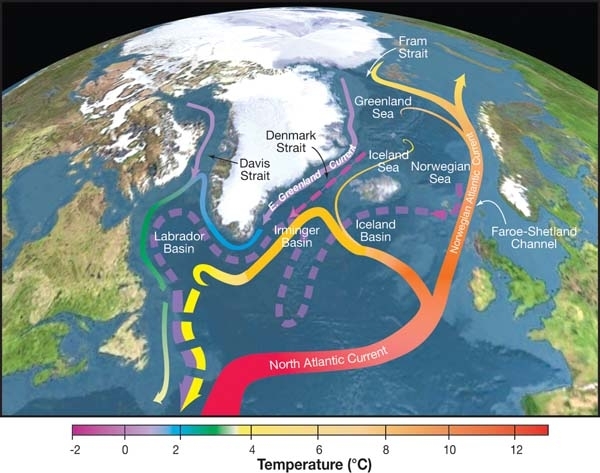
You may have seen the various media stories concerning this. It all revolves around a recently published study that concerns the Atlantic Meridional Overturning Circulation (AMOC). Perhaps you know it via the more familiar term “Gulf Stream”.
I’ve written on this topic before, so here are a few quick pointers to all of that …
- Jan 2017 – Future #Climate change could cause ocean current collapse
- Aug 2017 – Why is there a Weird warming hole in the Atlantic? – #Climate
- April 2018 – Dire News: Climate Change causing Ocean Circulation to slow down
- Back in July 2018 I was writing about a slowdown of the AMOC being an explanation for the Younger Dryas
- March 2019 – Changes in Ocean ‘Conveyor Belt’ Foretold Abrupt Climate Changes by Four Centuries
- Sept 2020 – Gulf Stream Update: New study confirms AMOC is slowing
- Feb 2021 – Study: Gulf Stream Collapse is a possibility
- March 2021 – Study: Gulf Stream really is slowing down
What we now have is a new update, so let’s dig into that.
Study: Observation-based early-warning signals for a collapse of the Atlantic Meridional Overturning Circulation
Published Aug 5, 2021 in Nature Climate Change, it reveals that the AMOC may have been losing stability in the course of the last century.
That should truly worry us. The AMOC picks up and transports heat from the tropics, carries it up along the eastern US coast and on towards Europe. There in sinks and flows south again. Think of it as a giant conveyor belt transporting heat north . This has a huge impact upon the climate. If it stops abruptly, then northern Europe will become a lot colder. Due to the rather severe consequences of this possibility, it is actively studied.
This latest study now brings new insights.
“The Atlantic Meridional Overturning really is one of our planet’s key circulation systems, We already know from some computer simulations and from data from Earth’s past, so-called paleoclimate proxy records, that the AMOC can exhibit – in addition to the currently attained strong mode – an alternative, substantially weaker mode of operation. This bi-stability implies that abrupt transitions between the two circulation modes are in principle possible.”
Author of the study, Niklas Boers from the Potsdam Institute for Climate Impact Research, Freie Universität Berlin and Exeter University
AMOC Fingerprints pointing towards a possible change
We don’t have a long history of direct measurements for the AMOC, hence working out what might be going on is challenging. If we measure everything right now, then with nothing to compare it with we can’t spot a trend.
We do however have other measurements such as sea surface temperature records and also salinity patterns. These are all influenced by the AMOC and so variations of these over time do give us an indirect understanding of the AMOC. The study authors refer to these as “fingerprints” that the AMOC leaves behind.
“A detailed analysis of these fingerprints in eight independent indices now suggests that the AMOC weakening during the last century is indeed likely to be associated with a loss of stability, The findings support the assessment that the AMOC decline is not just a fluctuation or a linear response to increasing temperatures but likely means the approaching of a critical threshold beyond which the circulation system could collapse.”
These indirect measurements suggest that the AMOC is rapidly running out of steam and may be close to a point where it simply stops.
Why is this happening?
Because of the warming in the arctic, vast amounts of freshwater are pouring off Greenland into the North Atlantic. This dilutes the salty water.
This is the region where the warm water coming from the south sinks and then returns south again. Freshwater is not as dense as saltwater. Because the current is being diluted it does not sink down as it once did.
“I wouldn’t have expected that the excessive amounts of freshwater added in the course of the last century would already produce such a response in the overturning circulation,” says Boers. “We urgently need to reconcile our models with the presented observational evidence to assess how far from or how close to its critical threshold the AMOC really is.”
When will it stop?
There is no conclusion for this, nobody knows.
What is clear is that what we have here is a signal that is clearly warning us of an impending change that is linked to human-caused climate change.
If it does happen, then our climate will be radically altered very rapidly. Even the very possibility of this is something we can’t ignore.
